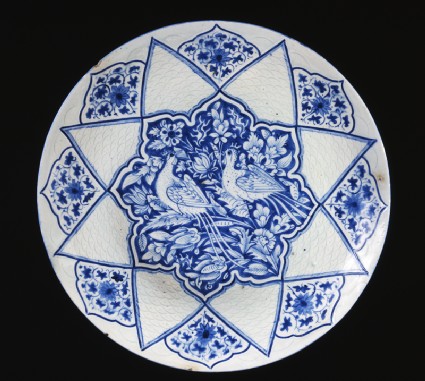Browse: 655 objects
- Reference URL
Actions
Dish with pheasants amid foliage
-
Description
Chinese ceramics and porcelain were eagerly collected by Islamic rulers in Egypt, Turkey and Iran from the early 15th century onwards. Through substantial purchases and rich diplomatic gifts, the collections of the Topkapi Palace in Istanbul and the Ardabil Shrine in Iran are not surprisingly amongst the most representative and comprehensive outside of China.
Blue-and-white Chinese porcelain, especially the refined wares of the Ming dynasty (1368-1644), have had a lasting impact on Islamic ceramic production. They not only influenced shapes and glazing techniques, but also enriched the decorative repertoire. Floral motifs like the lotus and the peony, fantastic creatures such as dragons and phoenixes, and fluttering cloud-bands became part of the Islamic artistic vocabulary at this time.
This impressively large plate shows how Eastern-inspired motifs could be used in combination with more indigenous patterns to produce highly inventive compositions. Here a vignette featuring two pheasants amidst peonies and lush vegetation acts as the centrepiece of a dynamic composition with three interlacing eight-pointed stars. Along with the balanced juxtaposition of coloured and plain areas, additional texture is provided by a moulded scale-like pattern that fills the white areas of the plate.
-
Details
- Associated place
- Date
-
17th century (1601 - 1700)
Safavid Period (1501 - 1722)
- Material and technique
- fritware, with incised decoration and underglaze painting in blue
- Dimensions
-
7.7 cm (height)
48 cm (diameter)
at foot 27.5 cm (diameter)
- Material index
- Technique index
- Object type index
- No. of items
- 1
- Credit line
- Gift of Gerald Reitlinger, 1978.
- Accession no.
- EA1978.2169
-
Further reading
Allan, James W., Islamic Ceramics, Ashmolean-Christie's Handbooks (Oxford: Ashmolean Museum, 1991), no. 37 on p. 60, illus. p. 61
Oxford: Ashmolean Museum, 24 May 2006-23 December 2008, Treasures: Antiquities, Eastern Art, Coins, and Casts: Exhibition Guide, Rune Frederiksen, ed. (Oxford: Ashmolean Museum, 2006), no. 179 on p. 64, illus. p. 64
Glossary (3)
fritware, porcelain, underglaze painting
-
fritware
Ceramic material composed of ground quartz and small quantities of clay and finely ground frit (frit is obtained by pouring molten glass into water).
-
porcelain
Ceramic material composed of kaolin, quartz, and feldspar which is fired to a temperature of c.1350-1400⁰c. The resulting ceramic is vitreous, translucent, and white in colour.
-
underglaze painting
Painting applied to ceramic material before a transparent, or monochrome or coloured glaze for Islamic objects, is applied. The technique was initially developed in China.
Location
Objects are sometimes moved to a different location. Our object location data is usually updated on a monthly basis. Contact the Jameel Study Centre if you are planning to visit the museum to see a particular object on display, or would like to arrange an appointment to see an object in our reserve collections.
Galleries
Publications online
-

Islamic Ceramics
The synthesis involved in the design of this splendid dish is not quite so complex as that on the previous one (no. 36 [EA1986.50]), but it provides an interesting and impressive variation on the same theme. Here the two pheasants amid peonies in the central roundel are copied painstakingly from imported Chinese blue and white designs, while the faint incised patterns in the points of the inner star derive from the moulded designs used on sixteenth century Chinese ceramics. The two eight-pointed star designs which surround them, however are part of the inherited Islamic taste for geometric patterns. In few other Safavid objects are they so successfully contrasted and combined.
© 2013 University of Oxford - Ashmolean Museum









